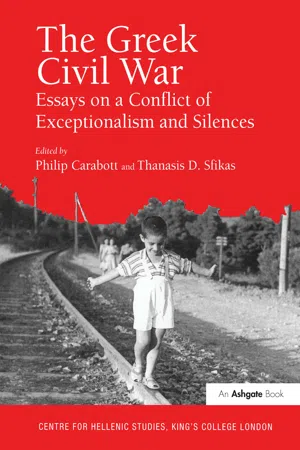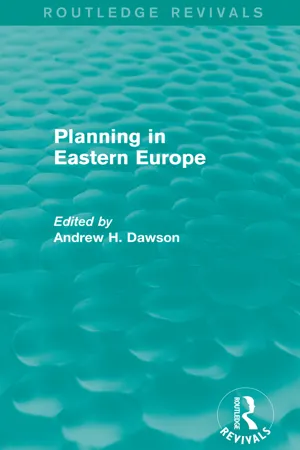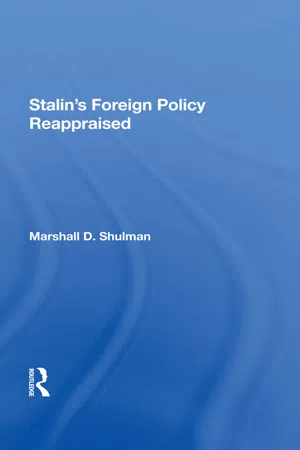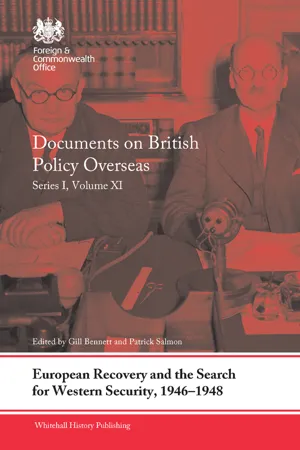History
Cominform and Comecon
Cominform was an organization established in 1947 by the Soviet Union and its Eastern European satellite states to coordinate communist parties and policies. Comecon, established in 1949, was an economic organization aimed at integrating the economies of the Eastern Bloc countries under Soviet influence. Both organizations were part of the Soviet Union's efforts to maintain control over its satellite states during the Cold War.
Written by Perlego with AI-assistance
Related key terms
5 Key excerpts on "Cominform and Comecon"
- eBook - ePub
The Greek Civil War
Essays on a Conflict of Exceptionalism and Silences
- Thanasis D. Sfikas, Philip Carabott(Authors)
- 2017(Publication Date)
- Routledge(Publisher)
It never became a decision-making instrument, its role being merely to ‘guide’ and to co-ordinate. Essentially it was an additional valuable tool of Stalinist authority – a component of the communist ideological and political strategy. In the main the Cominform acted as an accredited porte-parole of Soviet policy. According to Andrei Zhdanov’s drawing of the new geopolitical map, which perceived ‘the world as divided into two basic camps’, 7 the Cominform headed ‘the democratic and anti-imperialist camp’. From its very inception, therefore, the immediate political goals of this new organization were formulated as follows: the exercise of Soviet authority in the socialist camp; hardened opposition and mobilization of the masses in the capitalist camp; and a co-ordinated pursuit of the policy of the communist camp for peace. In fact these aims also reflected the Eurocentric dimension of the communist movement in 1945–49, that is, until the victory of the Chinese revolution. 8 Indeed, the invitation to participate in the Cominform’s organizational nucleus to only nine European communist parties 9 demonstrates that Soviet foreign policy focused its interest on Europe, which was then threatened by ‘Marshallization’. The setting up of the Information Bureau was a specific response to the Truman Doctrine and the Marshall Plan, exemplifying the simultaneous entrenchment and controlled offensive with which the communist world chose to counter the American presence in Europe - eBook - ePub
A History of Eastern Europe
Crisis and Change
- Robert Bideleux, Ian Jeffries(Authors)
- 2007(Publication Date)
- Routledge(Publisher)
They also initiated a series of ‘specialization agreements’ designed to curb costly industrial duplication and import-substitution, especially in those states that lacked the appropriate resource base to sustain autarkic neo-Stalinist patterns of industrialization. In 1956 ten permanent standing commissions were established to promote specialization and co-operation in particular sectors (Brabant 1989 : 46–7, 52–4). Comecon was revitalized, and its scope extended, partly in response to an extension of the range of tasks and challenges confronting the Soviet Union under its frenetic new party leader, Nikita Khrushchev (1953–64). The Soviet Union increasingly relied on the Balkans and especially East Central Europe to provide the types of machinery, equipment, manufactured consumer goods and foodstuffs that were in short supply domestically and to provide ‘captive’ markets for Soviet-produced plant, machinery, armaments and oil (Mellor 1971 : 14). (The Soviet Union initially faced difficulties in breaking into international oil markets controlled by Western multinational oil companies.) The December 1955 and May 1956 Council Sessions of Comecon called for the co-ordination and synchronization of national Five-Year Plans. In practice, however, most of the attempts at plan co-ordination at this time were limited to bilateral ex post harmonization of the trade implications of national economic plans and failed to achieve ex ante harmonization of either trade intentions or planned production (Brabant 1989 : 51) - eBook - ePub
- Andrew H. Dawson(Author)
- 2017(Publication Date)
- Routledge(Publisher)
imparium from the world as completely as possible. It was also seen, variously, as Soviet retaliation against Western actions following the blockade of Berlin, a means to make more effective the ostracism of Yugoslavia, and as a way of strengthening centripetal tendencies - drawing the satellites closer to the Soviet Union - after the centrifugalism of 1947 and 1948. It was further suggested that Stalin's belief that the 'all-embracing world market' of pre-war times had collapsed into 'capitalist' and 'socialist' markets underlay the idea that COMECON might be appropriately used to organise the latter.Organisation and Aims
Whatever the objective, COMECON is faced with significant geographical, economic and social differences between its members, though in every dimension of geography, economics, natural resources, population and political influence the Council is dominated by the Soviet Union. The other members fall into several groups - one containing the more advanced economies with a considerable industrial component - Czechoslovakia, the GDR, Poland, and perhaps Hungary - and a second including the countries with strong agrarian elements Bulgaria, Romania, Yugoslavia and, for a short period, Albania. A third, more recently admitted group includes the backward economies of the non-European members - Cuba, Mongolia and Vietnam.COMECON is a rigid, hierarchical bureaucracy, typical of the management patterns of the socialist bloc, and decisions and directives tend to filter slowly through its cumbersome administration. The key to the development of policy is the annual meeting of the Council, attended by the premiers of member countries, their chief planners and any necessary ministerial heads, which meets in a different capital city on each occasion, and is chaired by that country. As the highest organ within the structure it makes the key decisions (Figure 11.1 - eBook - ePub
- Marshall D. Shulman, Robert Legvold(Authors)
- 2019(Publication Date)
- Routledge(Publisher)
5 In the ascendancy from 1946 until midsummer 1948 as an authoritative spokesman for the regime and heir-apparent to Stalin, Zhdanov enforced stringent ideological conformity at home as well as vigorous militancy in foreign policy. At the Cominform session, he proclaimed the revival of the doctrine of the division of the world into two hostile camps, a doctrine last emphasized during an earlier militant period of Soviet policy (1928–1934).The practical consequences of this doctrine became apparent almost immediately. In Eastern Europe, decisions taken at the Cominform meeting were revealed by the coup in Czechoslovakia and by an acceleration of the process by which non-Communist leaders were eliminated or subjugated in Poland, Hungary, Rumania, Bulgaria, and Albania. Despite strenuous efforts, the Soviet Union was unable to extend political control over Yugoslavia as well, but its miscalculated and heavy-handed attempt to do so produced within a few months the first rupture in the new imperial system. In Western Europe, the Communist parties were obliged to turn away from the parliamentary path to power they had been following since the end of the war. By 1946, the French Communists had developed a theoretical base for a distinctive national path to socialism, by evolution through the stage of “popular democracy.”6 Whatever its ultimate possibilities, the main function of this line had been to support Soviet diplomatic efforts, expressed in the Franco-Soviet Treaty of 1944 and in promises of Soviet support for French interests; the intention was to keep General de Gaulle from allowing France to become a continental bridgehead for a Western bloc.7 - eBook - ePub
European Recovery and the Search for Western Security, 1946-1948
Documents on British Policy Overseas, Series I, Volume XI
- Gill Bennett, Patrick Salmon(Authors)
- 2016(Publication Date)
- Routledge(Publisher)
No. 215 below.No. 190 Note by Mr Lambert (Russia Committee), 7 November 1947
Top Secret (FO 371/66373, N 12755/271/38G)
The Cominform1The Secretary of State is suspending judgement on the real significance of the Cominform and of the Declaration which accompanied the announcement of its establishment, until we can see whether it results in changes of Soviet and Communist policy and tactics and can estimate whether it marks a new phase and if so what are the characteristics of that new phase.The Russia Committee has therefore decided that heads of departments should be asked to keep their eyes open for any indication of such changes, which appear to date from about the time of the ‘Warsaw Conference’ (which was held at the end of September and which led up to the Cominform Declaration) and should bring them to the notice of Northern Department without delay. Northern Department will submit memoranda from time to time drawing attention to such evidence as there may be of a new development in Soviet and Communist policy.2A copy of the Declaration is attached.3 Broadly speaking the main features of this document appear to be its insistence upon the two worlds, its militant tone, its condemnation of the Right Wing Socialists and its emphasis on the leading part which Communist Parties must play in rallying the anti-Imperialist forces and in revealing their growing strength. It may, therefore, mark the end of what might loosely be described as the ‘Popular Front phase’ and the opening of a phase which might be—also loosely—described as Communism versus the Rest.4
Learn about this page
Index pages curate the most relevant extracts from our library of academic textbooks. They’ve been created using an in-house natural language model (NLM), each adding context and meaning to key research topics.




